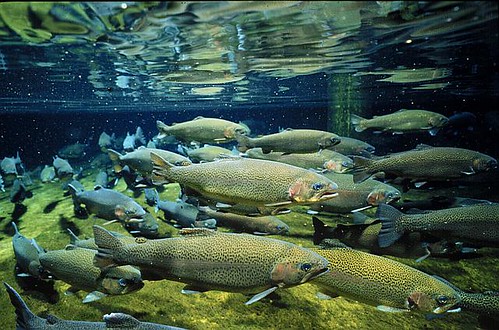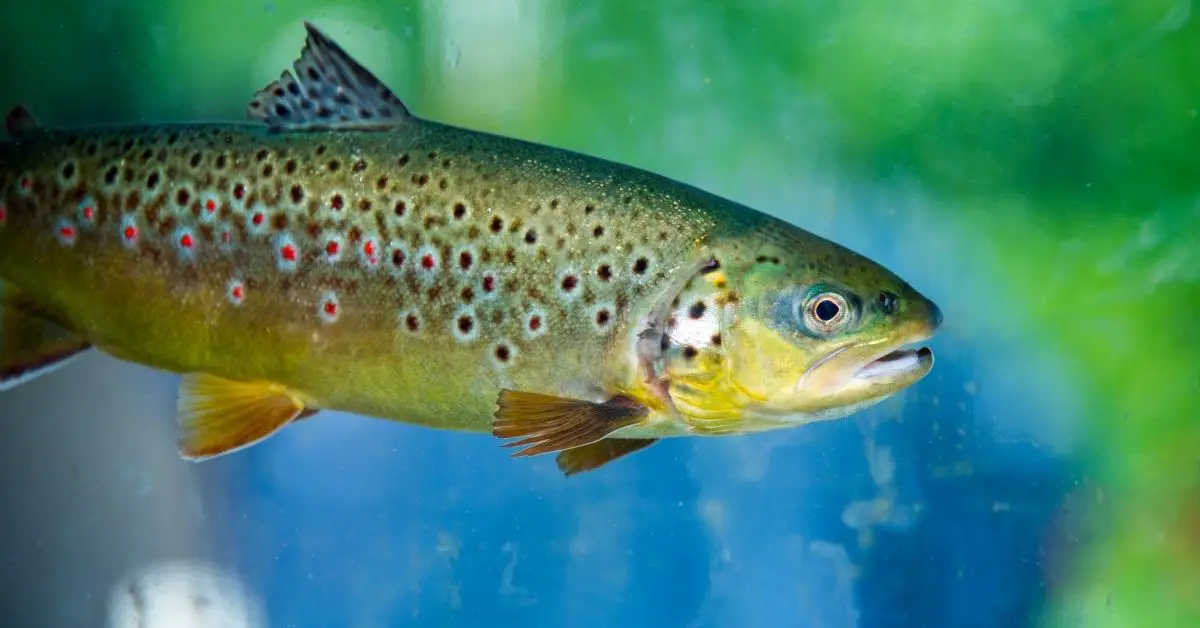In this blog post, I will explore how to stock trout into your pond as well as what they need to survive.
The first step is deciding whether or not your pond can support fish life. If it’s too shallow, then the water temperature won’t stay cool enough for these cold-blooded creatures.
It also needs to be deep and wide enough so that weeds don’t grow and block sunlight from reaching underwater plants and algae which provide oxygen and food for the fish.
Can rainbow trout live in ponds?
Yes, they can – but only if you have a lot of water in your pond.
Rainbow trout, like other salmonids such as brown and lake trout, are well suited to living in rivers and lakes. They can be found in most temperate bodies of water across the world.
Cutter Backyard Bug Control Spray Concentrate (2 Pack), Kills Mosquitoes, Fleas & Listed Ants, 32 fl Ounce
35% OffLIANGLOME Solar Fence Lights Outdoor - 2700/4000/6000K 3 Mode, Waterproof LED, Fence Light Solar Powered for Outside, Backyard/Railing/Step/Patio/Wall and Home Improvement(8 Pack)
16% OffGOOTOP Bug Zapper Outdoor, Mosquito Zapper, 3 Prong Plug in Electric Fly Zapper, Mosquito Killer, Fly Traps, Flying Insects Zapper Indoor Outdoor 90-130V, 4200V, ABS Plastic Outer (Black)
33% OffThe problem with keeping them in ponds is that these fish often outgrow their water supply quickly. When this happens they become agitated and can be a danger to nearby livestock.
In order for them not to outgrow their water supply, ponds must contain a lot of water. This is often impractical as these fish are typically stocked as fingerlings at around 2-3 inches in length – by this time they already require more room than the average pond can provide. As they grow they will become more and more agitated in their restricted space, potentially inflicting harm on any livestock that comes too close.
At best, the fish will stay in its small pond for just a year or two before it must be moved elsewhere. As such, unless you live near an abundant source of water these fish are not suitable for life in a pond.
If you plan on keeping a supply of rainbow trout, bear in mind that they can grow very quickly and may need replacing within a few years if your pond isn’t massive.

Rainbow trout pond requirements
If you want to add Rainbow trout to your pond, there are some basic requirements your pond needs before you stock.
It needs to be at least 2m deep and wide because Rainbow trout need this depth to survive winter in the cold North American climate. They will die in shallow ponds when temperatures drop below freezing in the winter months!
The water should also contain some form of aquatic plants for them to hide in because they are very vulnerable to other fish and animals while they’re young.
The pond should also have a constant flow of fresh water coming into it. This can be achieved with a water pump connected to an outside source such as a stream or river.
Rainbow trout need this continuous inflow of cold, clean water to stay cool and alive during the heat of summer.
Your best bet is to keep your fish inside a commercial fish pond to start with and only transferring them outside once they’re big enough. This way you won’t risk your young trout dying because of the summer heat.
There should also be some form of vegetation around the edge of your pond for cover from predators such as other fish and birds.
This is especially important if the pond is open to the sky and not enclosed.

What do Rainbow trout eat?
Rainbow trout are primarily carnivores but will also eat plant matter when it’s available. They primarily feed on insects, mollusks, crustaceans, and other fish. In a pond, there’s bound to be plenty of aquatic invertebrates such as snails and insects such as mosquitoes for them to eat.
There’s also plenty of vegetation around the edge of your pond that they can feed on.
The best type of food to give your fish would either be sinking pellets or freeze-dried meat such as bloodworms and brine shrimp. Both of these foods sink and will be right near the bottom of the pond where your trout can feed on them easily.
When you’re just starting out, it’s best to only feed your fish small amounts of food at each meal. This decreases the risk that they’ll be overfed and have extra nutrients pollute their water. They should only eat what they need.
Rainbow trout are also opportunistic carnivores and will eat other fish if they’re small enough to fit in their mouth. They also feed on water birds such as ducks and swallows who come to your pond for a drink.
I wouldn’t recommend using live fish as food because it’s cruel and could lead to cannibalism between the trout which is harmful to their health.
What size pond do you need?
You’ll need to have at least 1000 gallons of water if you want 6 rainbow trout. This is because they are big fish and each one will get about 1 foot long in their adulthood. If you want different sizes, then make sure the ratio of large to small is similar for all of your trout.
For a pond of 1000 gallons, you’ll need a minimum of 1 square foot of surface area for each gallon. Since your trout will take up at least 1 square foot, this means that the pond needs to be at least 2m deep and wide if you want 6 fish or bigger.
If you’re only going for smaller sizes then your pond doesn’t need to be as big. Try and make it 8 times larger than the trout you want in your pond though. This way, they have enough space for each fish to grow into healthy adult size.
Do rainbow trout get along with other fish?
Yes, but keep in mind that they are predatory carnivores so will eat anything they can fit in their mouth. They especially like to eat smaller fish and other trout.
They will not get along with most species of fish, even other species of rainbow trout. Even siblings from the same egg won’t get along because they’re overly competitive for food and space.
You can add small invertebrates such as snails or insects into your fish pond without affecting the trout’s diet. I wouldn’t recommend adding other types of fish because they stress your rainbow trout out, making them less healthy.
Can you have catfish and trout in the same pond?
Yes, it’s possible to have both of these types of fish in the same pond.
Some people even breed their own species of catfish with rainbow trout because they’re compatible.
Just keep in mind that if you add larger types of catfish into your pond then you’ll need a bigger tank. They grow quite big and will be more than enough food for your trout to eat.
Trout are opportunistic carnivores and will eat whatever else they can fit in their mouth, including catfish if they’re big enough. Catfish aren’t the only fish your rainbow trout will try eating though. If it’s small enough to fit in their mouth then they’ll probably try eating it.
What about other animals?
No type of animal can live in a fish pond with your rainbow trout except what they themselves eat. They will eat any animal that enters their territory so it’s best to keep the pond covered with netting if it’s open on top.
You can leave some vegetation around the edge of your pond for ducks and other birds to come drink from but try keeping the water deeper than 6 feet so they don’t get into your trout’s territory.
Rainbow trout are also territorial animals that will fight over food and territory with other rainbow trout. The only exception to this is that they will sometimes share their home with another species of rainbow trout although they still fight for food and territory even then.
What about diseases?
Rainbow trout are not the hardiest fish in the world. They have a high mortality rate because they can get several diseases, some of which are fatal.
Different diseases will affect different parts of a rainbow trout’s body. For example, bacterial infections might lead to a swollen belly while fungal infections might cause lesions on its skin or fins.
Fish that have contracted one disease may be more likely to get another so try and quarantine them if you notice any symptoms that you think might be deadly.
There are many different types of fish diseases so it’s best to do some research on them before you buy any fish so that you can identify the symptoms and treat your trout accordingly if necessary.
To recap
The rainbow trout is a predatory carnivore and will eat anything they can fit in their mouth. They especially like to eat smaller fish and other trout, which means that having them in the same pond as another type of fish may not be such a great idea.
If you’re going for catfish then just keep in mind that if they grow too big then your tank size needs to increase accordingly because it’s likely they’ll try eating the rainbow trout.
There are many different types of diseases these poor guys get so make sure you know what symptoms look like before buying any.
Keep a netting over your pond to prevent other animals from entering their territory and leave some vegetation around the edges for birds to drink from.
References:
Rainbow trout Oncorhynchus mykiss https://www.fws.gov/southeast/wildlife/fishes/rainbow-trout/




















